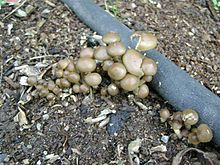| Psilocybe stuntzii | |
|---|---|

| |
| Scientific classification | |
| Domain: | Eukaryota |
| Kingdom: | Fungi |
| Division: | Basidiomycota |
| Class: | Agaricomycetes |
| Order: | Agaricales |
| Family: | Hymenogastraceae |
| Genus: | Psilocybe |
| Species: | P. stuntzii
|
| Binomial name | |
| Psilocybe stuntzii Guzmán & J. Ott
| |
| Psilocybe stuntzii | |
|---|---|
| Gills on hymenium | |
| Cap is convex or umbonate | |
| Hymenium is adnate or sinuate | |
| Stipe has a ring | |
| Spore print is purple-brown | |
| Ecology is saprotrophic | |
| Edibility is psychoactive | |
Psilocybe stuntzii, also known as Stuntz's blue legs and blue ringers it is a psilocybin mushroom of the family Hymenogastraceae, having psilocybin and psilocin as main active compounds.
It is in the section Stuntzae, other members of the section include Psilocybe caeruleoannulata, Psilocybe meridionalis, Psilocybe mescaleroensis, Psilocybe ovoideocystidiata, Psilocybe rostrata, Psilocybe subaeruginascens, Psilocybe subaeruginascens var. septentrionalis and Psilocybe uruguayensis.
